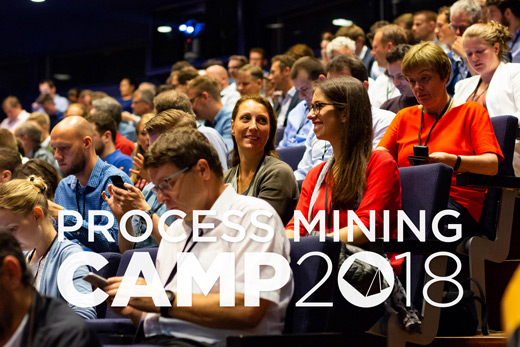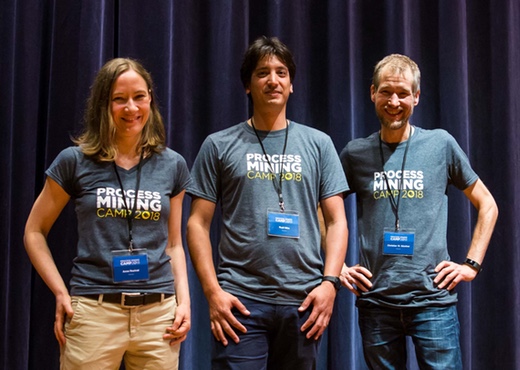Recap of Process Mining Camp 2018
![]()
Every year, it is a truly amazing experience for us to welcome process miners from all over the world at the annual Process Mining Camp. This year, people came together from 16 different countries!
Here is a short summary of this year’s camp. Sign up at the camp mailing list to be notified about next years camp and to receive the video recordings once they become available.
Opening Keynote
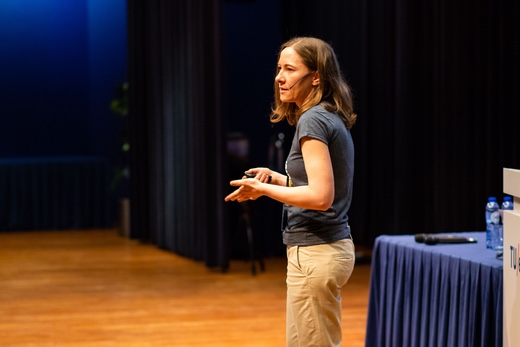
Anne Rozinat, co-founder of Fluxicon, opened the camp by emphasizing that process mining is more than just a tool – it is developing into a discipline. Over the years, more than 2000 process miners have been trained to apply process mining in practice. After completing the training, they understand the depth of the skills that are needed, and they often ask: How can I become really good at this?. Training is a good starting point, but you need to put your knowledge into practice to further develop your process mining skills.
Successful process miners have skills in four key areas (data, process, management, and leadership), based on which we have now developed a process mining certification framework. Knowledge about preparing your data, and being able to analyze your data from a process perspective, lie at the heart of the process mining skillset. But you also need to be able to lead the way to drive the business change to make a significant impact. Furthermore, managerial skills are crucial to realize and sustain the benefits within an organization.
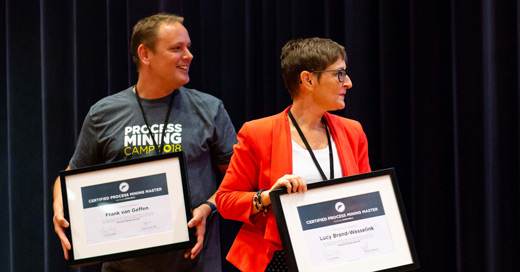
Frank van Geffen (Rabobank) and Lucy Brand-Wesselink (ALFAM) are both leaders in the process mining field. They have managed to complete complex process mining projects with significant benefits, and they could prove that they fulfil all requirements to obtain the Process Mining Master certification. This excellence was also affirmed by their sponsors who co-signed their certification.
Fran Batchelor – UW Health, United States
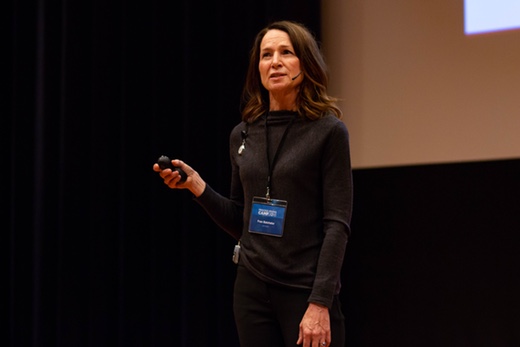
Fran Batchelor was the first speaker of the day. Fran used to be a nurse practitioner specialized in surgery operation for many years. Today, she works as a nursing information specialist at UW Health, where she improves the surgical operations. One of her challenges was to find a way to best allocate operating room space for urgent and emergent surgical cases (so-called ‘Add on’ cases) which have to be handled on top of the scheduled surgical care. Some of the specialty services have dedicated hold rooms for their add-on cases while others have to fit them into their regular schedule. When two new operating rooms were built, departments were competing about who should get access to them as a hold room for add-on cases. With process mining, Fran analyzed the process flows of the add-on cases for these departments. She could show the impact that having a dedicated hold room has on meeting the internal performance metrics and, as a result of her process mining analysis, the decision about how to allocate these new resources was made differently than initially planned.
Niyi Ogunbiyi – Deutsche Bank, United Kingdom
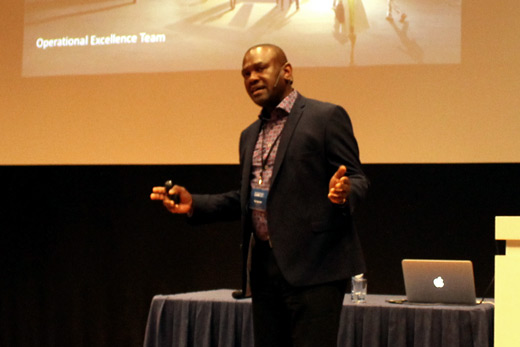
Niyi Ogunbiyi was the second speaker. As a Six Sigma Master Black Belt in the Chief Regulatory Office (CRegO) Operational Excellence Team, he shared five lessons he learned when introducing process mining at Deutsche Bank. One of the lessons was that you need to be aware and communicate clearly what process mining can do – but also what it can’t do. For example, Process mining will help you to find bottlenecks quickly, but you need additional techniques to find and address the root cause. Improving processes goes further than just pointing out the problem. Another lesson was that you need to have a balance between explorative analyses and finding answers to defined questions. Process mining has the advantage that it enables you to discover valuable things that you did not even know you were looking for. But such untargeted exploration can also be very time consuming. Niyi showed some examples of how they structured their targeted analyses around business questions and recommended to spend about 30% of your time on untargeted and 70% on the targeted exploration of your data in your project.
Dinesh Das – Microsoft, United States
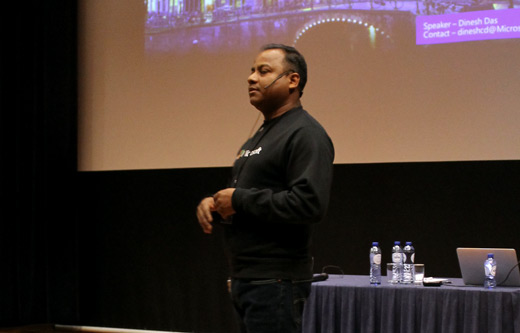
The third speaker of the day was Dinesh Das. Dinesh is the Data Science manager at Microsoft’s Core Services and Engineering and Operations unit. He shared his vision of how process mining can be used to accelerate the digital transformation. To illustrate his vision, Dinesh presented a Proof of Concept that he implemented for a Global Trade process, including a live demo. In the demo, he showed how process mining plays a crucial part in the implementation of a real-time monitoring solution by deriving the business rules for the monitoring. Furthermore, he demonstrated how Cognitive Analytics and other machine learning techniques can be integrated with the monitoring platform to interactively support the decision making for the people who are working in this process.
Wim Kouwenhoven – City of Amsterdam, The Netherlands
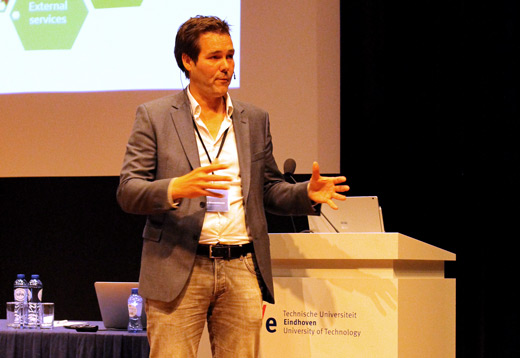
The fourth speaker was Wim Kouwenhoven, a program manager for the financial function of the municipality of Amsterdam. He introduced process mining as one of the initiatives to stabilize and improve the financial function. He learned that the adoption of a new technology like process mining requires a new approach. It starts with awareness and the involvement of the right people: Sponsorship at the right level is important to experiment and learn how to apply process mining in practice. Wim suggested to start small but focus on getting some tangible results quickly. After this first step, you need to take a step back and link your process mining experiences with the business objectives. Then you are ready to select the right initiatives and focus your process mining efforts on the most promising opportunities. Wim closed his presentation by sharing how process mining has helped them to address human project challenges, by reducing emotions and by increasing knowledge sharing between team members.
Olga Gazina – Euroclear, Belgium
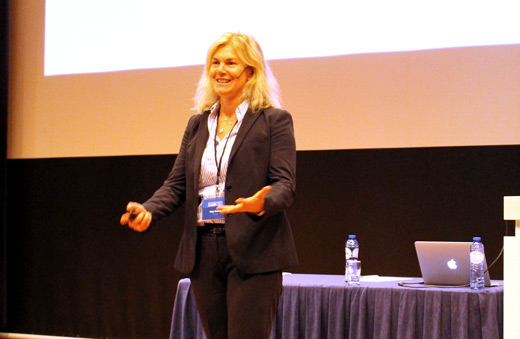
Olga Gazina from Euroclear was the fifth speaker. Olga was accompanied by her colleague Daniel Cathala, who – as the process owner – explained the Software Configuration Management Lifecycle process in the Component & Data Management group at Euroclear. This is an important process for Euroclear to be able to update and release their IT services quickly and with high quality. Olga is a data analyst who works for the Internal Audit department. While wearing two hats in this project (data analyst and auditor), she worked with Daniel and his team to create a process mining-based view of their process. At camp, Olga shared the many iterations she had to go through to find the right representation of this complex process. ‘Right representation’ means a representation of that process that the team recognizes as their own. Finding this representation required asking a lot of questions for Olga and a change in thinking for the team. Ultimately, they succeeded and it opened up new perspectives and ideas for them.
Marc Tollens – KLM, The Netherlands
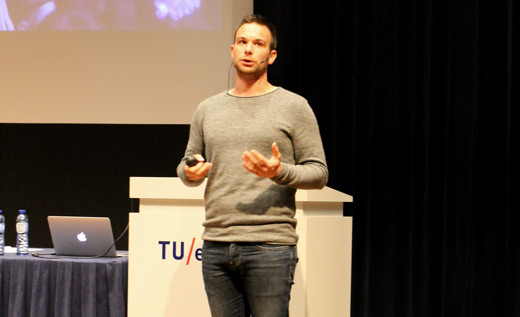
As the sixth speaker, Marc Tollens presented his Sunday afternoon pet project: As a product owner at KLM he had seen that some agile teams were completing less items than they initially planned. Because he knew process mining from previous projects, he had the idea that one could analyze the process that the teams follow in each sprint. Would he be able to learn something about their way of working that could help improve the development process? Marc extracted data from Jira, an agile project management tool, and started comparing the processes for multiple development teams. He observed that each of these teams had problems in different parts of the process: Some teams were very new, some started testing too late, and some made the scope too big to be achieved within the sprint. By discussing these insights based on the process maps with the teams, Marc could help them see what was blocking them and address the specific challenges each team had.
Process Miner of the Year 2018 awards
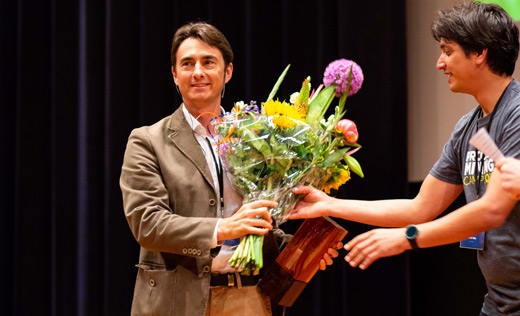
Every year, only one process process miner is awarded the title of Process Miner of the year. This year, David Baltar Boilve showcased an exceptional project that he completed at the Hospital Universitario Lucus Augusti in Spain. In this project, he analyzed how mouth cancer patients actually move through the hospital until they are diagnosed. We will share the case study describing Davids analysis and results in a dedicated article here on the blog in the coming weeks. So, stay tuned!
Wil van der Aalst – RWTH Aachen, Germany
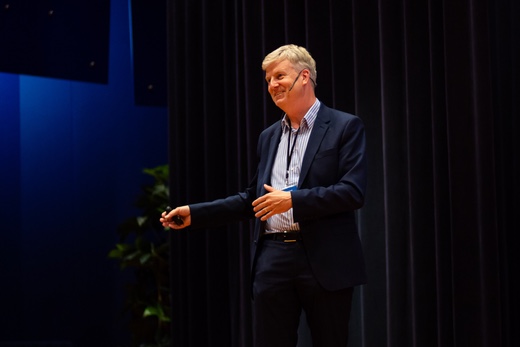
Wil van der Aalst gave the closing keynote at camp. After receiving the prestigious Alexander von Humboldt professorship award, Wil continues his process mining research at his new Process and Data Science chair at the RWTH Aachen University. Currently, his research is focused on four main areas: (1) Foundations of process mining, (2) Dealing with different types of event data, (3) Automated operational process improvement, and (4) Responsible process mining.
In his keynote, Wil shared his view on the skills that data scientists need today and examined how others are defining the data science landscape. He also warned that we should all be careful not to overpromise what Artificial Intelligence can do to avoid another “AI winter”.
Second Day: Workshops
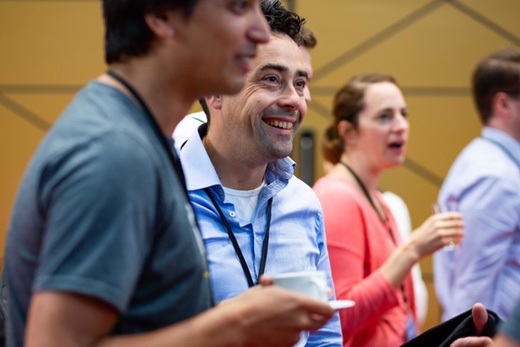
On the second day of camp, 128 process mining enthusiasts joined one of the four workshops. Marc Gittler and Patrick Greifzu explained how process mining fits in the different phases of the audit process from preparation to reporting. Eddy van der Geest guided the workshop participants through the steps to prepare data easily and efficiently with a state-of-the-art data analysis and ETL tool. Rudi Niks showed how to overcome the common challenges when applying process mining to analyze customer journeys. Anne Rozinat taught the participants how to answer 20 typical process mining questions.
We would like to thank everyone for the wonderful time at camp, and we can’t wait to see you all again next year!
Photos (C) by Lieke Vermeulen and Rudi Niks
Leave a Comment
You must be logged in to post a comment.
